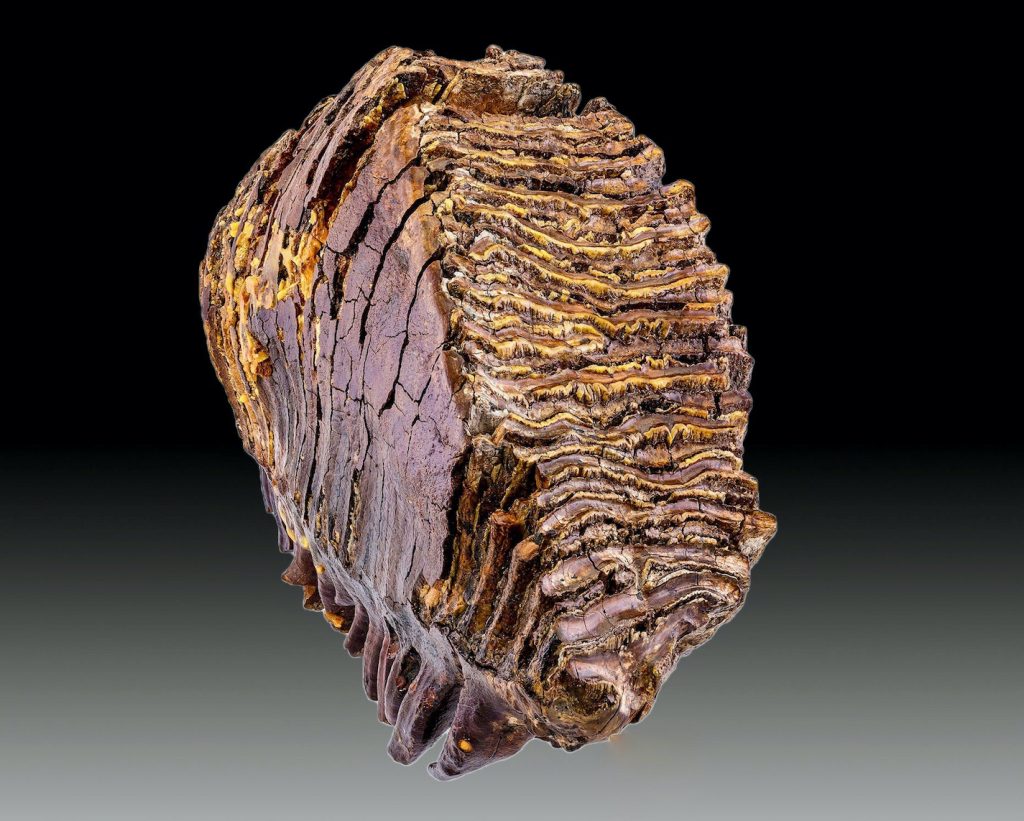In 1999, hunters on St. Paul Island —with 70 square miles the biggest of the Pribilof cluster’s spent volcanoes—stumbled upon a sensation: a 40-foot-deep lava tube beneath tundra, housing a charnel hoard. During a 2003 expedition to Qagnax Cave, named after the Aleut word for “bone,” University of Alaska Anchorage scientists sorted its faunal debris. Among more than 1,750 fragments, most from foxes the pit had devoured, lay five woolly mammoth shards plus two teeth. Mammoths made up one third of Alaska’s paleo-mammal biomass, so that alone hardly warranted much excitement. But dates obtained by various methods at different labs did. Kristine Crossen, a UAA geologist, “couldn’t believe it at first.” Radiocarbon decay measures showed that this animal breathed roughly 5,700 years ago, 4,000 after its last known relative roamed our continent.
The island once overlooked Beringia, a land bridge extension of the “mammoth steppe” the size of Alaska plus Alabama. As the glacial epoch’s largest biome, these rolling grasslands linked Spain and northern Canada via Siberia. Late-Pleistocene icecaps storing additional snow had lowered ocean levels 160 feet. Having crossed exposed Bering Strait seafloor, hunters of East Asian descent with their dogs and families about 13,500 BP scouted Alaska’s interior and the Yukon, opportunistically spearing or scavenging reddish-orange, strawberry-blond, or chestnut-brown jumbos, each of which Hoovered the equivalent of four alfalfa bales daily. Rising seas around 11,000 BP engulfed America’s threshold again. Subsequent migrants, Aleut and Eskimo ancestors, reached the New World in skin boats. Wildlife moving upward from flood zones got marooned in refugia.

Bugling still shattered silence on Siberia’s Wrangel Island in 4,300 BP, centuries after the completion of Giza’s Great Pyramid. Insular woollies could be 10 percent smaller—fairly common in deprived, confined populations—but they were no dwarf race like California’s Channel Islands mammoth; in height, they rivaled African elephants. Mainland mammoths forged on until circa 10,000 BP. Wetter, warmer years turned steppe into forest and tundra, with the behemoths’ decline reinforcing the trend. Saplings no longer trampled became woods less reflective than prairies. Snow, like a down blanket, no longer compacted, screened soil from cooling winds.
Unsurprisingly, Alaska’s state fossil keeps making the news. Bioengineers want to resurrect it as a niche-filler in rewilded experimental settings or “Pleistocene parks.” Inland rivers and coastal storms frequently bare sudden organic outcrops, the dome-headed grazers’ remains. Shishmaref duck hunters in 2018 pulled a 12-foot, 177-pound, shiny, teak-colored tusk, a flaring C whose tip poked from a cutbank. Already in 1815, the Russian circumnavigator Otto von Kotzebue on his Pacific loop found “a very fine tooth” near today’s town bearing his name. Prospectors unearthed log-like femurs, jousting ivories signaling bulls’ and cows’ status and health, and washboard-ridged molars abraded by gritty food. In 1948, “Effie,” a rare, 20,000-year-old mummified calf, eroded from Fairbanks Creek’s bluffs. Nineteenth-century rumors of her kin’s survival owed to a zoologist aboard USRC Corwin to whom Cape Prince of Wales Inupiat offered bones and tusks in trade. Bering Strait Eskimos long familiar with half-buried pachyderm parts they carved into tools took them as proof of mythical creatures tunneling underground that died when they surfaced, inhaling. The beast the collector sketched on the ship’s deck for them embodied the enigma whose continued existence they might then have affirmed.

Outlier species from dodos to giant tortoises often lingered—or arose—in predator-free island havens until sailors, settlers, or ecological shifts doomed them. The question of what finished St. Paul’s holdouts has vexed paleontologists. They’ve considered “overkill,” the idea that early human arrivals hunted wildlife to extinction—70 percent of North America’s megafauna simply disappeared. However, except for stray Aleut kayakers, Russian sealers in the 1780s were the first people to land on St. Paul.
UAF researchers probing the mystery in 2013 cored lake sediments on this Beringian remnant. The layers revealed poor water quality during the tuskers’ vanishing; algae and aquatic insects entombed in the muck profiled the region’s dwindling ice-age lakes. Nitrogen isotopes of an organism’s diet leave unique, local signatures in its skeleton, which underscored creeping aridity before the St. Paul bruisers’ end. Lack of fresh water, for Matthew Wooller of UAF’s Water and Environmental Research Center, was “the smoking gun” of causes that coalesced into a dire situation. When melting ice caps shrank the island to its present dimensions, its shaggy tanks ran out of fuel.
This study, among the most fine-grained to ever pinpoint prehistoric extinction, is yet another reminder of small populations’ balancing acts, of their vulnerability to changed circumstances. Compared to the St. Paul scenario, droughts and sea level rises we trigger will seemingly strike overnight. Mammuthus primigenius, one of the last in a line of at least six mammoth species, through millennia failed to adapt to the threat. Homo not-quite-so sapiens and fellow creatures now at best have decades to do so.



Comments are closed.